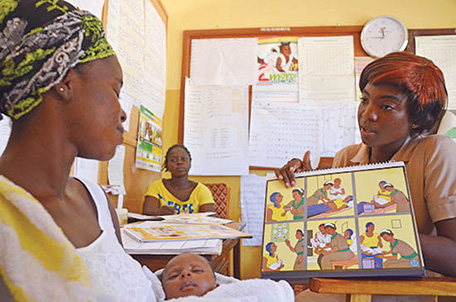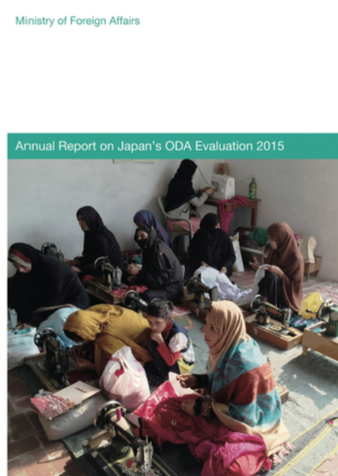ODA Topics 05
Highlights from the Annual Report on Japan’s ODA Evaluation 2015
To Improve ODA through Evaluation
Purpose of the Annual Report on Japan’s ODA Evaluation
In addition to the White Paper on Development Cooperation, the Ministry of Foreign Affairs (MOFA) publishes the Annual Report on Japan’s ODA Evaluation, which provides an overview of ODA evaluation every year, since 1982.
We have two objectives for the evaluations: 1) To help improve Japan’s ODA management; and 2) To ensure accountability to the people of Japan for whether Japan’s ODA has been implemented appropriately.
To pursue the first objective, which is to improve Japan’s ODA management, it is necessary to examine whether Japan’s ODA towards regions of the world has been implemented effectively and whether such ODA is contributing to the development of the recipient countries. If any room for improvement is identified, it will have to be addressed and reflected in Japan’s future ODA activities.
To meet these objectives, MOFA annually selects approximately eight ODA topics on the basis of factors such as priority themes and sectors of Japan’s development policy, as well as the countries where Japan has implemented many ODA projects, and entrusts external experts to conduct third-party evaluations. The results of these evaluation studies and the corresponding recommendations for future improvements of Japan’s ODA activities are published as evaluation reports.
MOFA then publishes an annual report in pursuit of the second objective of ODA evaluation, which is to secure public support and understanding on Japan’s ODA. The annual ODA Evaluation Report contains results of ODA evaluations conducted during the past year, as well as a brief description of how the Government responded to past recommendations by external experts.
Based on the idea that evaluations should be carried out from an objective standpoint, the third-party ODA evaluations and the annual ODA Evaluation Report are managed and prepared by a section that is independent from the section in charge of ODA and specially designated for ODA evaluation in MOFA.
Outline of the Annual Report on Japan’s ODA Evaluation 2015

Project for Improvement of Maternal and Neonatal Health Services Utilising CHPS System in the Upper West Region (Photo: Takeshi Kuno)
The Annual Report on Japan’s ODA Evaluation 2015 is composed of three chapters and a reference section.
Chapter 1 gives an overview of Japan’s ODA evaluation system and its background, as well as international trends in ODA evaluation. Chapter 2 presents an overview of the results and corresponding recommendations of the third-party evaluation conducted by MOFA in 2014, and explains measures taken by MOFA and JICA in response to these recommendations.
It also contains an outline of ODA evaluations conducted by government ministries other than MOFA and by JICA, as ODA evaluations conducted by the Government of Japan are not limited to those managed by MOFA. The chapter also presents an overview of the evaluation of Japan’s ODA from the perspective of the recipients of assistance.
Nine topics received third-party evaluations in FY 2014. Among these, the Evaluation of Japan’s Contribution to the Achievement of the Millennium Development Goals (MDGs) in the Health Sector, and the Country Assistance Evaluation of Kenya are introduced.
Japan’s contribution in the health sector was selected as a topic for evaluation as it was deemed to have reached an important milestone. Japan has formulated a series of development cooperation policies in the health sector, including Japan’s Global Health Policy 2011-2015 and Japan’s Strategy on Global Health Diplomacy, since the adoption of the MDGs in 2000. In addition, Japan has engaged in various assistance initiatives, both bilaterally and through international organizations.
Considering that 2015, the end of the duration of the MDGs, was drawing near, an overall evaluation was carried out on Japan’s efforts to achieve the health-related MDGs. The evaluation aims to serve as useful reference when formulating new policies in the health sector.
The results of the evaluation demonstrated that Japan’s ODA policies in the health sector (initiatives, etc.) are generally consistent with trends in assistance of the international community known through the MDGs, G8 Summits and other international institutions. Also, the degree of improvement in the health outcome indicators was higher in regions where Japan made overall efforts to give health service assistance than in other regions. Based on these results, it can be inferred that the effect of Japan’s ODA in the health sector has increased.

Front cover of the Annual Report on Japan’s ODA Evaluation 2015
With regard to the goals in the health sector outlined in the SDGs which will succeed the MDGs, it was recommended that as an advanced country, Japan should play a major role in Sub-Saharan Africa and conflict/post-conflict countries where the needs of health sector assistance are higher and large improvements in health standards is necessary. Based on these evaluation results, the Government of Japan launched the Basic Design for Peace and Health (Global Health Cooperation) as Japan’s new policy for assistance in the health sector.
Despite Kenya being a leading country in Africa and having received continuous and large assistance from Japan over the years, the country assistance evaluation of Kenya has not been conducted since 2005. Therefore, Kenya became the country subject to evaluation this year.
The evaluation results were positive overall, however some issues were pointed out regarding Kenyan citizens’ recognition for Japan’s ODA. It was recommended that the Government of Japan should forge public relations in order to improve the recognition of Japan’s ODA to Kenya.
In response, the Government of Japan took steps to formulate a public relations strategy to boost Kenyan citizens’ recognition for Japan’s ODA through publicity activities, including press releases to local media on occasions such as ceremonies for the completion of facilities built with Japan’s assistance, use of social network services, and advertising in newspapers.
Chapter 3 reports on the status of the follow-up measures to the eight ODA third-party evaluation studies conducted in FY 2013.
For example, the evaluation of assistance to the African Millennium Villages (AMV) Initiative stated that although the project was implemented through international organizations and Japan was not in a position to directly manage and supervise its progress, Japan needs to validate results and seek sufficient feedback so that the assistance could become reference for new approaches in providing aid taking into account its policy intention, as a trial run for new aid approaches. Based on this evaluation, one of the recommendations was to strengthen the project implementation management system.
It was reported that, in response to this recommendation, the Government of Japan engaged in efforts to strengthen the project management system. Specifically, in regard to the AMV Initiative being implemented with grant aid, Japan requested that the United Nations Office for Project Services (UNOPS), which is the implementing agency, regularly report to Japan’s diplomatic missions in each country.
The recommendations in the evaluation of assistance under the Initiative for Disaster Risk Reduction were: “Mainstreaming of Disaster Risk Reduction (DRR)” and “Formulation of a new initiative with a clear message.” In response to these recommendations, Japan promoted mainstreaming of disaster risk reduction through the Sendai Framework for Disaster Risk Reduction 2015-2030 adopted at the Third United Nations World Conference on Disaster Risk Reduction (WCDRR), and also announced the Sendai Cooperation Initiative for Disaster Risk Reduction, as Japan’s new initiative in the field of disaster risk reduction. (See ODA Topics.)
Reports of each evaluation and the Annual Reports are available to the public on the MOFA website. For further information and more details on the evaluations, please visit the following link.
http://www.mofa.go.jp/mofaj/gaiko/oda/kaikaku/hyoka.html
* The AMV is a part of the Millennium Village Project (MVP). The MVP is a comprehensive assistance program proposed by the United Nations Millennium Project (UNMP). It aims to eliminate extreme poverty through a comprehensive development approach, and aims to develop communities with self-sustaining development capabilities. This project targets impoverished villages in Sub-Saharan Africa where the achievements of the MDGs have been delayed.
